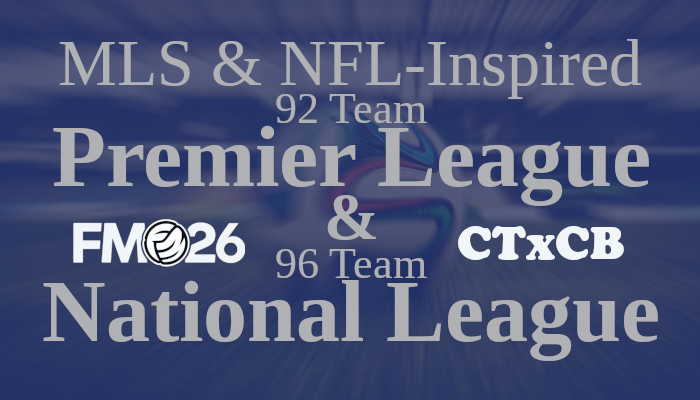
Central Defender (CD)
His main job is to stop opposing players from playing the ball and clearing it from a dangerous area when needed. In more aggressive tactics, he must also possess the technique and composure to maintain possession and lay off simple passes to his teammates.With a defend duty, the central defender will stay in line with his defensive partner and look to break up attacks, mark opposing forwards and prevent the ball from getting into the box.
With a stopper duty, the central defender will push ahead of the defensive line and close down players before they get into the area.
With a cover duty, the central defender will drop deep and sweep up through balls behind the defensive area.
Locked Instructions: Shoot Less Often, Dribble Less, Fewer Risky Passes
Key Attributes: Heading, Marking, Tackling, Anticipation, Bravery, Concentration, Decisions, Determination, Positioning, Jumping Reach, Strength, and Aggression
Cover Duty: Acceleration is a key attribute since he needs to recover quickly
Other Variations:
PPM: Plays No Through balls & Runs With Ball Rarely for Possession Tactics
Defend First PPM: Stay Back At All Times
• Generic defenders who are a good option for any side
• Will play the ball out of defence or in the air.
• Team instructions and mentality can influence their play, sometimes they will play the ball long when there are no adequate passing options.
• Movement – Does not leave the defensive line
Ball-Playing Defender (BPD)
In FM20 a change has been made to this role allowing it to bring the ball out of defence as a default, since in essence he operates with the ‘bring ball out of defence’ player trait, which suggests that you will need the right player to perform this role. Under some transitions you could find your BPD all the way in the opponents final third.His main job is to stop opposing players from playing the ball and clearing it from a dangerous area when needed. He is also encouraged to start defence-splitting passes from deep to generate counter-attacking chances. He has an active instruction to play more risky passes. This defender is expected to be comfortable on the ball.
With a defend duty, the BPD will stay in line with his defensive partner and look to break up attacks, mark opposing forwards and prevent the ball from getting into the box
With a stopper duty, the BPD will push ahead of the defensive line and close down players before they get into the area.
With a cover duty, the BPD will drop deep and sweep up through balls behind the defensive area.
• Technically proficient player, good first touch, dribbling, passing, vision and technical defender attributes
• Can launch deep diagonal attacks from the back if there are good options in front. Eg an Inside Forward on attack duty playing against the high press, with space to attack
• Risky role if used with players who have poor first touch, composure and dribbling
• When paired with a sweeper keeper they can counter a high press or prevent short GK distribution
• Can be used very effectively in a 5 man or a 4 man defensive line
• Movement – Dynamic role that can leave the defensive line to initiate attacks or break lines (eg, Move from defensive line to midfield)
• Real life example: Virgil Van Dyke (Liverpool), Matthis De Light (Juventus)
Locked Instructions: More Risky Passes and/or Hold Position
Key Attributes: Heading, Marking, Tackling, Anticipation, Bravery, Concentration, Decisions, Determination, Positioning, Jumping Reach, Strength, Aggression, First Touch, Technique, Vision, Passing, Composure
Cover Duty: Acceleration
Other Variations:
PPM: Tries Killer Balls Often, Stays Back at All times
EXAMPLES
When a defender can play killer balls from deep he adds something different to the team He will initiate attacks from deep and can be highly effective especially in 3 man defences. A very good example of a ball playing defender in the modern game is Borussia Dortmund’s Mats Hummels. He averages 21m in passing length and was one of the primary playmakers when Jurgen Klopp was managing them.
If a defender is given the stay back at all times ppm, he will seek to stay back all the time instead of launching forward. This variation can ensure that he doesn’t go charging off from the defensive line.


In the screenshot above the team is NOT playing the Play out of Defence Team instruction. Instead its told the keeper to distribute the ball to the central defenders only. BPDs are encouraged to play the ball out of defence, and they will work to bring the ball out.

The BPD brings the ball out as far as the RPM before he plays the ball out to the wings. Its important to recognise this behaviour. When he comes across a playmaker he will reassess his choices before either passing it to him or going with someone else. If you add the “dribble more” player instruction he could end up bypassing the playmaker and continuing to try and beat players with the dribble to look for others to pass the ball to.
Whenever BPDs are playing in a system with the Play out Of Defence team Instruction and are on a positive mentality they sometimes go as far as down the flanks in the final third.
No Nonsense Central Defender (NCB)
His main job is to stop opposing players from playing the ball and clearing it from a dangerous area when needed. He tries to win the ball without giving away free kicks and his priority is to clear the ball to safety.With a defend duty, the DCB will stay in line with his defensive partner and look to break up attacks, mark opposing forwards and prevent the ball from getting into the box.
With a stopper duty, the DCB will push ahead of the defensive line and close down players before they get into the area.
With a cover duty, the DCB will drop deep and sweep up through balls behind the defensive area.
Locked Instructions: Shoot less often, Dribble Less, More Direct Passes, Fewer Risky passes and/or Hold Position (Defend duty only)
Key Attributes: Heading, Marking, Tackling, Determination, Positioning, Jumping Reach and Strength
Other Variations:
No Nonsense Defender PPM: Plays no through balls, Refrains From Taking Long Shots, Runs with Ball Rarely, Stays Back At All Times
• Ideal role for players who are not great with passing, first touch or dribbling
• A role that plays direct balls into space or towards a player
• Ideal role for sides that want to play defensive football where clearing the ball is the first priority
• Can be used by any team as an option for a deep strike when they are playing with attacking duties in the final third
Libero - Support and Attack
The Libero drops behind the defensive line, aiming to sweep up through balls, pick up extra attackers and make goal saving tackles, blocks and interceptions.His exceptional athleticism and reading of the game enable him to cover for defensive errors, take possession of loose balls from a deep position and secure possession. However he will also roam forwards in support of the midfield when in possession
We can now play the Libero in a 3 man defence with either a support or attack duty.
With a support duty, the Libero steps into midfield when possession is secured and look to play balls through to attacking teammates.
With an attack duty, the Libero ventures much higher up the pitch to provide a goal scoring threat from distance and play others in.
Locked Instructions:
Support Duty: More Risky Passes
Attack Duty : Shoot More Often, More Risky Passes, Get Further Forward, Dribble More
Key Attributes:
Support Duty: Heading, Marking, Passing, Tackling, Anticipation, Composure, Concentration, Decisions, Positioning, Teamwork, Acceleration, Balance, Jumping Reach
Attack Duty: Heading, Marking, Passing, Tackling, Anticipation, Composure, Concentration, Decisions, Positioning, Teamwork, Acceleration, Balance, Jumping Reach, Pace, Stamina
• Creative central defender, passing, decisions, vision, and dribbling are recommended attributes to have in addition to central defender attributes
• Technically proficient player
• Can push out of his defensive line when he brings the ball out of defence
• To bring the best out of him, it’s best not to have playmakers ahead of him
• A good role for playmakers who need to be retrained as they get older as long as the defenders around them are fast
EXAMPLES
The Libero is one of the classic roles in football best personified by Franz Beckenbaur. This role is slowly making some inroads after being a historical footnote. You can still get this role to work with the right combination of ppms and player instructions. The best modern example of a player who has the potential of becoming a Libero is probably David Luiz who currently plays for Antonio Conte in his Chelsea side. That is also a coach who has experimented with the use of the Libero.

Here I am using a Libero on support note what happens when we are playing out of defence and have no playmakers in front of him in a 5212, he has pushed high into the opponents third.

In most cases the libero will sit and form a three in defence, on occasions he will push forward.






![TinyHips' Dark Mode Skin v5.2 [Win + MacOS] *UPDATED 26.1.0*](assets/downloads/fm26/fm26-dark-mode-skin.th.png)


![FM26 Data Tweaks [v1.1 | v1.6]](assets/downloads/fm26/fm26-data-tweaks-by-sirtavares-v2.th.png)

Discussion: Book of Roles: Central Defenders
No comments have been posted yet..